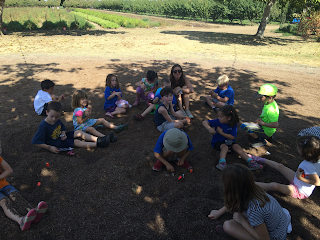Crows and owls cleaned the school's vegetable/fruit garden:
The owls visited Center for Land-Based Learning (farm by the creek). The kids learned about tree grafting, the importance of pollinators in farms, and how farmers harvest walnuts.
 |
| Animals and plants observational drawings. |
 |
| While visiting the walnut orchard owls were able to see and feel different types of walnut trees. Some kids were also able to open the walnuts and try them. |
 |
| Owls learning about native bees from an UC Davis graduate student. He talked to the kids about the importance of bees for food production and showed them the diversity of bees. |
 |
| Pollination game. The owls were bees carrying pollen from flower to flower. The kids learned about the 3 different ways in which bees can carry pollen and tried to mimic them. |
 |
| The owls learned different eye structures and made models showing the pupil and iris. If you are an owl parent, ask your child if s/he remembers the function of the pupil. |
 |
| The owls are exploring the 5 senses. We started with sight - here you can see students trying to identify mysterious materials without looking at them. |
 | ||||||
| Teacher Juliette helping owls explore optical illusions. We talked about how our brain can trick our eyes and students were exposed to different games that illustrate some of the tricks. |
 |
| The crows (5-6) are learning about cells. Here you can see the kids drawing the general structure of plant and animal cells. |
 |
| During math the crows created an accurate, scaled map of the native areas that we are developing. The kids had to create the grid on paper and land. |
 |
| More cell study. The crows learned how to properly use microscopes - they looked at pine stem, blood cells and plant epidermal cells. |
 |
| Students drawing animals that they would like to see at the school. Lorie and I are sending these drawings as part of the proposal that we are submitting to U.S Fish and Wildlife Service. |
 |
| The kids made paper straws and dipped them in wax to make them water proof. These straws will be used to make bee houses (solitary bee species). |
 |
| Students in the after school class built a worm farm and bird houses. Here you can see the kids working on the worm farm. |
 |
| Crows and owls planting peas around the teepee. |
 |
| Crows and owls planting nitrogen fixing plants in the garden. |
 | ||
| The owls built a music wall at the school. They learned about how the ear works and used their engineering skills to create a music wall. |
 |
| The eagles doing strip mulching in the native area to kill the grass and prepare the soil for planting. |
 |
| Eagles adding the vernal pool to the native area. We are very lucky to have some vernal pool soil. The kids love to see the creatures emerging in the pool as the rainy season starts. |






































No comments:
Post a Comment